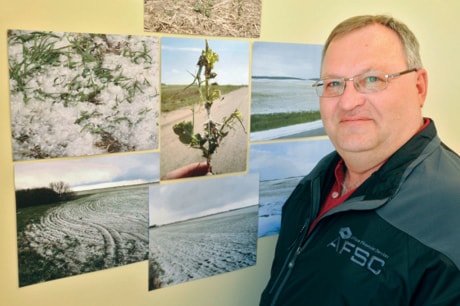Record years for hail insurance claims in 2007 and 2008 do not necessarily signal a trend, says the provincial adjusting manager with Agriculture Financial Services Corp.
Gilbert Goudreau, who works out of AFSC’s head office in Lacombe, said Alberta farmers have suffered severe hail losses during many years in the past.
And so far this year, he added, there have been relatively few incidents of ice falling from the sky.
“At this time last year, we had quite a number of hail claims.
“We started getting hailstorms and we were getting them day after day in May and June.”
Last year ended with $73.5 million in straight-hail payouts to Alberta producers, smashing the previous record of $40.3 million set the preceding year.
A factor that inflated the 2007 and 2008 numbers was a jump in crop values, confirmed Goudreau.
“The other thing in 2008 was that we had a lot of specialty crops down south that got hail.”
Still, Environment Canada reported a record 89 severe hailstorms in 2007. The figure dropped to 66 last year, but many of those were very intense and far-reaching, said Goudreau.
“We had more offices reporting,” he said, explaining that single hailstorms were generating claims in multiple jurisdictions.
The Calgary-Edmonton corridor was among the hardest-hit areas in 2008, which is not uncommon for the region.
“At Gull Lake, we had areas where we had three storms,” said Goudreau, adding that a similar situation occurred at Olds.
Ironically, the dry conditions stressing Central Alberta crops this spring have translated into a reduced risk of hail. But that could change quickly with precipitation that increases ground-level moisture that in turn fuels hailstorms.
Goudreau pointed out that large bodies of water, such as Sylvan, Gull and Pigeon lakes, also promote hail. Storms often split when they hit a lake, he added, citing Gull Lake as an example.
“Usually you get one arm that heads toward Red Deer, Innisfail and that area, and the other one will catch usually Ponoka and head that way.”
It’s too early to assess the demand for hail insurance this year, said Goudreau, but the high cost of farm inputs like fertilizer and the frequency of storms during the last two years could spur producers to insure.
Conversely, some might be deterred by the prospects of a poor crop in 2009, he acknowledged. However, as long as an insured farmers has a harvestable crop, he or she would be eligible for compensation for hail damage.
“Hail insurance is spot loss.”
Damage from hail on Monday was probably minimized by the fact the cold spring has left area crops are well behind their normal pace of development, said Goudreau. But the situation could be different the next time thunderheads form.
Once a crop suffers severe hail damage, he noted, it may no longer qualify for coverage. So it’s better to act now.
“If you’re going to buy it next week, you might as well buy it today — same price.”
hrichards@www.reddeeradvocate.com
Goudreau pointed out that large bodies of water, such as Sylvan, Gull and Pigeon lakes, also promote hail. Storms often split when they hit a lake, he added, citing Gull Lake as an example.
“Usually you get one arm that heads toward Red Deer, Innisfail and that area, and the other one will catch usually Ponoka and head that way.”
It’s too early to assess the demand for hail insurance this year, said Goudreau, but the high cost of farm inputs like fertilizer and the frequency of storms during the last two years could spur producers to insure.
